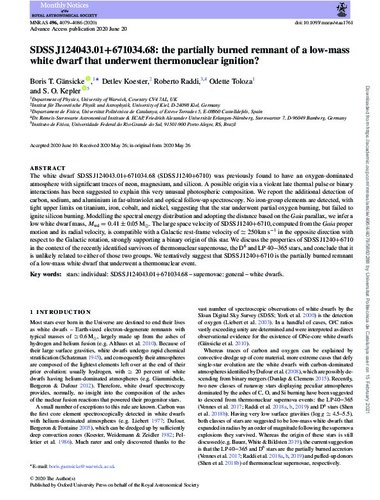Exploració per autor "Koester, D."
Ara es mostren els items 1-7 de 7
-
DA white dwarfs from the LSS-GAC survey DR1: the preliminary luminosity and mass functions and formation rate

Rebassa Mansergas, Alberto; Cojocaru, Elena Ruxandra; Torres, S.; García-Berro Montilla, Enrique; Liu, X.; Yuan, H-B.; Xiang, M.-X.; Huang, Y.; Koester, D.; Hou, Y.; Li, G.; Zhang, Y. (2015-06-11)
Rebassa Mansergas, Alberto; Cojocaru, Elena Ruxandra; Torres, S.; García-Berro Montilla, Enrique; Liu, X.; Yuan, H-B.; Xiang, M.-X.; Huang, Y.; Koester, D.; Hou, Y.; Li, G.; Zhang, Y. (2015-06-11)
Article
Accés obertModern large-scale surveys have allowed the identification of large numbers of white dwarfs. However, these surveys are subject to complicated target selection algorithms, which make it almost impossible to quantify to ... -
Gaia white dwarfs within 40 pc – I. Spectroscopic observations of new candidates

Tremblay, P. E.; Hollands, M.; Izquierdo Tugas, Pere; Gänsicke, Boris T.; Koester, D.; Brown, W J; Hermes, J. J.; Kleinman, Scot J.; Manser, C. J.; Marsh, Thomas R.; Schreiber, Mathias R.; Silvotti, R.; Rebassa Mansergas, Alberto; Raddi, Roberto (Oxford University Press, 2020-09-01)
Tremblay, P. E.; Hollands, M.; Izquierdo Tugas, Pere; Gänsicke, Boris T.; Koester, D.; Brown, W J; Hermes, J. J.; Kleinman, Scot J.; Manser, C. J.; Marsh, Thomas R.; Schreiber, Mathias R.; Silvotti, R.; Rebassa Mansergas, Alberto; Raddi, Roberto (Oxford University Press, 2020-09-01)
Article
Accés obert
Realitzat a/amb: University of Warwick / Universidad de La Laguna / Universitat Christian Albrecht de KielWe present a spectroscopic survey of 230 white dwarf candidates within 40 pc of the Sun from the William Herschel Telescope and Gran Telescopio Canarias. All candidates were selected from Gaia Data Release 2 (DR2) and in ... -
Orbital periods and component masses of three double white dwarfs

Rebassa Mansergas, Alberto; Parsons, S. G.; García-Berro Montilla, Enrique; Gaensicke, B. T.; Schreiber, Mathias R.; Rybicka, M.; Koester, D. (2017-04-01)
Rebassa Mansergas, Alberto; Parsons, S. G.; García-Berro Montilla, Enrique; Gaensicke, B. T.; Schreiber, Mathias R.; Rybicka, M.; Koester, D. (2017-04-01)
Article
Accés obertThe merger of close double white dwarfs (CDWDs) is one of the favourite evolutionary channels for producing Type Ia supernovae (SN Ia). Unfortunately, current theories of the evolution and formation of CDWDs are still ... -
SDSS¿J124043.01+671034.68: the partially burned remnant of a low-mass white dwarf that underwent thermonuclear ignition?

Gänsicke, Boris T.; Koester, D.; Raddi, Roberto; Toloza, Odette; Kepler, S.O. (Oxford University Press, 2020-08-21)
Gänsicke, Boris T.; Koester, D.; Raddi, Roberto; Toloza, Odette; Kepler, S.O. (Oxford University Press, 2020-08-21)
Article
Accés obertThe white dwarf SDSS¿J124043.01+671034.68 (SDSS¿J1240+6710) was previously found to have an oxygen-dominated atmosphere with significant traces of neon, magnesium, and silicon. A possible origin via a violent late thermal ... -
Serendipitous discovery of a dusty disc around WDJ181417.84-735459.83

González Egea, E.; Raddi, Roberto; Koester, D.; Rogers, L. K.; Marocco, F.; Cooper, W. J.; Beamin, J. C.; Burningham, B.; Day-Jones, A.; Forbrich, J.; Pinfield, D. J. (Oxford University Press, 2021-03)
González Egea, E.; Raddi, Roberto; Koester, D.; Rogers, L. K.; Marocco, F.; Cooper, W. J.; Beamin, J. C.; Burningham, B.; Day-Jones, A.; Forbrich, J.; Pinfield, D. J. (Oxford University Press, 2021-03)
Article
Accés obertSpectroscopic observations of white dwarfs reveal that many of them are polluted by exoplanetary material, whose bulk composition can be uniquely probed this way. We present a spectroscopic and photometric analysis of the ... -
The SDSS spectroscopic catalogue of white dwarf-main-sequence binaries: new identifications from DR 9–12

Rebassa Mansergas, Alberto; Ren, J. J.; Parsons, S. G.; Gänsicke, Boris T.; Schreiber, Mathias R.; García-Berro Montilla, Enrique; Liu, X.; Koester, D. (2016-06-01)
Rebassa Mansergas, Alberto; Ren, J. J.; Parsons, S. G.; Gänsicke, Boris T.; Schreiber, Mathias R.; García-Berro Montilla, Enrique; Liu, X.; Koester, D. (2016-06-01)
Article
Accés obertWe present an updated version of the spectroscopic catalogue of white dwarf-main-sequence (WDMS) binaries from the Sloan Digital Sky Survey (SDSS). We identify 938 WDMS binaries within the data releases (DR) 9-12 of SDSS ... -
White dwarf pollution by hydrated planetary remnants: hydrogen and metals in WD¿J204713.76–125908.9

Gänsicke, Boris T.; Raddi, Roberto; Koester, D.; Pala, A. F.; Manser, C. J.; Belmonte, Merche; Hollands, M. (Oxford University Press, 2020-09-09)
Gänsicke, Boris T.; Raddi, Roberto; Koester, D.; Pala, A. F.; Manser, C. J.; Belmonte, Merche; Hollands, M. (Oxford University Press, 2020-09-09)
Article
Accés obertWD¿J204713.76–125908.9 is a new addition to the small class of white dwarfs with helium-dominated photospheres that exhibit strong Balmer absorption lines and atmospheric metal pollution. The exceptional abundances of ...








